*NURSING > QUESTIONS and ANSWERS > ATI. MATERNAL-NEWBORN (All)
ATI. MATERNAL-NEWBORN
Document Content and Description Below
1. Two days after delivery, a postpartum client prepares for discharge. What should the nurse teach her about lochia flow? Incorrect: Lochia does change color but goes from lochia rubra (bright red)... on days 1-3, to lochia serosa (pinkish brown) on days 4-9, to lochia alba (creamy white) days 10-21. Incorrect: Numerous clots are abnormal and should be reported to the physician. Incorrect: Saturation of the perineal pad is considered abnormal and may indicate postpartum hemorrhage. Correct: Lochia normally lasts for about 21 days, and changes from a bright red, to pinkish brown, to creamy white. The color of the lochia changes from a bright red to white after four days Numerous large clots are normal for the next three to four days Saturation of the perineal pad with blood is expected when getting up from the bed Lochia should last for about 3 weeks, changing color every few days 2. A nurse monitors fetal well-being by means of an external monitor. At the peak of the contractions, the fetal heart rate has repeatedly dropped 30 beats/min below the baseline. Late decelerations are suspected and the nurse notifies the physician. Which is the rationale for this action? Incorrect: A nuchal cord (cord around the neck) is associated with variable decelerations, not late decelerations. Incorrect: Variable decelerations (not late decelerations) are associated with cord compression. Incorrect: Late decelerations are a result of hypoxia. They are not reflective of the strength of maternal contractions. Correct: Late decelerations are associated with uteroplacental insufficiency and are a sign of fetal hypoxia. Repeated late decelerations indicate fetal distress. The umbilical cord is wrapped tightly around the fetus' neck The fetal cord is being compressed due to rapid descent of the fetal head Maternal contractions are not adequate enough to deliver the fetus The fetus is not receiving adequate oxygen and is in distress 3. Which preoperative nursing interventions should be included for a client who is scheduled to have an emergency cesarean birth? Incorrect: Monitoring O2 saturations and administering pain medications are postoperative interventions. Incorrect: Taking vital signs every 15 minutes is a postoperative intervention. Instructing the client regarding breathing exercises is not appropriate in a crisis situation when the client's anxiety is high, because information would probably not be retained. In an emergency, there is time only for essential interventions. Correct: Because this is an emergency, surgery must be performed quickly. Anxiety of the client and the family will be high. Inserting an indwelling catheter helps to keep the bladder empty and free from injury when the incision is made. Incorrect: The nurse should have assessed breath sounds upon admission. Breath sounds are important if the client is to receive general anesthesia, but the anesthesiologist will be listening to breath sounds in surgery in that case. Monitor oxygen saturation and administer pain medication. Assess vital signs every 15 minutes and instruct the client about postoperative care. Alleviate anxiety and insert an indwelling catheter. Perform a sterile vaginal examination and assess breath sounds. 4. Which nursing instruction should be given to the breastfeeding mother regarding care of the breasts after discharge? Incorrect: Engorgement occurs on about the third or fourth postpartum day and is a result of the breast milk formation. The primary way to relieve engorgement is by pumping or longer nursing. Giving a bottle of formula will compound the problem because the baby will not be hungry and will not empty the breasts well. Incorrect: Applying lotion to the nipples is not effective for keeping them soft. Excessive amounts of lotion may harbor microorganisms. Correct: In order to stimulate adequate milk production, the breasts should be pumped if the infant is not sucking or eating well, or if the breasts are not fully emptied. Incorrect: Using soap on the breasts dries the nipples and can cause cracking. The baby should be given a bottle of formula if engorgement occurs. The nipples should be covered with lotion when the baby is not nursing. The breasts should be pumped if the baby is not sucking adequately. The breasts should be washed with soap and water once per day. 5. A client in preterm labor is admitted to the hospital. Which classification of drugs should the nurse anticipate administering? Correct: Tocolytics are used to stop labor. One of the most commonly used tocolytic drugs is ritodrine (Yutopar). Incorrect: Anticonvulsants are used for clients with pregnancy-induced hypertension who are likely to seize. Incorrect: The glucocorticoids (e.g., betamethasone and dexamethasone) are used for accelerating fetal lung maturation and production of surfactant. They are commonly used if the membranes are ruptured or labor cannot be stopped. Incorrect: Anti-infective are used if there is infection. Preterm labor may or may not involve ruptured membranes with its accompanying risk of infection. Tocolytics Anticonvulsants Glucocorticoids Anti-infective 6. Which of the following are probable signs, strongly indicating pregnancy? Incorrect: The presence of fetal heart sounds is a positive sign of pregnancy; quickening is a presumptive Sign of pregnancy. Incorrect: These are presumptive signs. They may indicate pregnancy or they may be caused by other conditions, such as disease processes. Correct: These are probable signs that strongly indicate pregnancy. Hegar’s sign is a softening of the lower uterine segment, and Chadwick's sign is the bluish or purplish color of the cervix as a result of the increased blood supply and increased estrogen. Ballottement occurs when the cervix is tapped by an examiner's finger and the fetus floats upward in the amniotic fluid and then falls downward. Incorrect: These are presumptive signs that might indicate pregnancy, but they might be caused by other conditions, such as disease processes. Presence of fetal heart sounds and quickening Missed menstrual periods, nausea, and vomiting Hegar's sign, Chadwick's sign, and ballottement Increased urination and tenderness of the breasts 7. Two hours after delivery the nurse assesses the client and documents that the fundus is soft, boggy, above the level of the umbilicus, and displaced to the right side. The nurse encourages the client to void. Which is the rationale for this nursing action? Correct: Bladder distention can lead to postpartum hemorrhage. A full bladder displaces the uterus causing it not to contract properly. Emptying the bladder allows the uterus to contract more firmly. Incorrect: A distended bladder rises out of the abdomen, causing the uterus to be displaced and increasing the risk of hemorrhage. It does not affect the perineum. Incorrect: Bladder distention can lead to urinary stasis and infection. This, however, does not relate to the soft, boggy uterus or the potential for hemorrhage. Incorrect: Massaging is uncomfortable regardless of whether the bladder is full or not. A full bladder displaces the uterus causing it not to contract properly, which may lead to postpartum hemorrhage. A full bladder prevents normal contractions of the uterus. An overdistended bladder may press against the episiotomy causing dehiscence. Distention of the bladder can cause urinary stasis and infection. It makes the client more comfortable when the fundus is massaged. 8. Which site is preferred for giving an IM injection to a newborn? Incorrect: Ventrogluteal muscles are located in the hip area. It is not the preferred site for injections in the newborn because of lack of muscle mass. Correct: The middle third of the vastus lateralis is the preferred site for injections. Incorrect: Ventrogluteal muscles are located in the hip area. It is not the preferred site for injections in the newborn because of lack of muscle mass. Incorrect: Newborns do not receive injections in the dorsogluteal site (gluteus maximus) due to decreased muscle mass. Ventrogluteal Vastus lateralis Rectus femoris Dorsogluteal 9. During the first twelve hours following a normal vaginal delivery, the client voids 2,000 mL of urine. How should the nurse interpret this finding? Incorrect: Urinary tract infections are common during pregnancy and in the postpartum period. Urinary frequency is a common finding. However, voiding large amounts of urine is not a sign of a UTI. Incorrect: High output renal failure occurs with injury/trauma to the kidneys. There has been no damage to the kidneys. Incorrect: Most women do receive some IV fluids during labor and delivery, however the IV rates are carefully calculated according to weight. Correct: During pregnancy, the circulating blood volume increases by about 50%. In order to get rid of the excess fluid volume after delivery, the woman experiences an increased amount of urine output during the first few hours. Urinary tract infection High output renal failure Excessive use of IV fluids during delivery Normal diuresis after delivery 10. If a pregnant client diagnosed with gestational diabetes cannot maintain control of her blood sugar by diet alone, which medication will she receive? Incorrect: Glucophage is an oral hypoglycemic. Oral hypoglycemic cross the placenta and can cause damage to the fetus. They are not used in gestational diabetes for that reason. Incorrect: Glucagon is a hormone used to raise blood sugar and manage severe hypoglycemia. Clients with gestational diabetes have hyperglycemia. Correct: Insulin is the drug of choice for gestational diabetes. Insulin lowers the client's blood sugar without harming the fetus. Incorrect: DiaBeta is an oral hypoglycemic drug. Oral hypoglycemic agents cross the placenta and can cause damage to the fetus. They are not used for gestational diabetes for that reason. Metformin (Glucophage) Glucagon Insulin Glyburide (DiaBeta) 11. Which assessment finding indicates that placental separation has occurred during the third stage of labor? Incorrect: There is usually an increase in bleeding (a sudden gush of blood) when the placenta separates. Incorrect: Contractions continue in an attempt to expel the placenta. The contractions may not be as intense, but they do not stop. Also, fundal massage helps contract the uterus preventing postpartum bleeding. Incorrect: Shaking and chills occur about 10-15 minutes after the delivery of the baby, but are not related to the placental detachment. They are a result of the release of pressure on pelvic nerves and the release of epinephrine during labor. Correct: As the placenta detaches, the cord that has been clamped becomes longer as it slides out of the vagina. Decreased vaginal bleeding Contractions stop Maternal shaking and chills Lengthening of the umbilical cord 12. The nurse midwife is concerned about a pregnant client who is suspected of having a TORCH infection. Which is the main reason TORCH infections are grouped together? They are: Incorrect: Most TORCH infections can cause mild flu-like symptoms for the mother. Death may or may not occur in the fetus. Incorrect: TORCH is an abbreviation for Toxoplasmosis, Other (syphilis, HIV and Hepatitis B), Rubella, Cytomegalovirus, and Herpes simplex—not all of these are sexually transmitted. Correct: All TORCH infections have the capability of infecting the fetus or causing serious effects to the newborn. Incorrect: A vector is a carrier of the disease such as a mosquito. Not all of the TORCH infections are carried by vector. benign to the woman but cause death to the fetus. sexually transmitted. capable of infecting the fetus. transmitted to the pregnant woman by a vector. 13. During the postpartum period, a hospitalized client complains of discomfort related to her episiotomy. The nurse assigns the diagnosis of “pain related to perineal sutures.” Which nursing intervention is most appropriate during the first 24 hours following an episiotomy? Incorrect: Petroleum jelly will harbor bacteria, which may hinder healing. Incorrect: The client should practice Kegel exercises to increase bladder tone, but these exercises would add to the client's discomfort during the first 24hours.Incorrect: Taking a warm sitz bath is recommended after the first 24 hours. Correct: Ice packs will decrease edema and discomfort, and prevent formation of a hematoma. Instruct the client to use petroleum jelly on the episiotomy after voiding. Encourage the client to practice Kegel exercises. Advise the client to take a warm sitz bath every four hours. Apply ice packs to the perineum. [Show More]
Last updated: 1 year ago
Preview 1 out of 51 pages
Instant download
.png)
Buy this document to get the full access instantly
Instant Download Access after purchase
Add to cartInstant download
Reviews( 0 )
Document information
Connected school, study & course
About the document
Uploaded On
Mar 23, 2021
Number of pages
51
Written in
Additional information
This document has been written for:
Uploaded
Mar 23, 2021
Downloads
0
Views
31

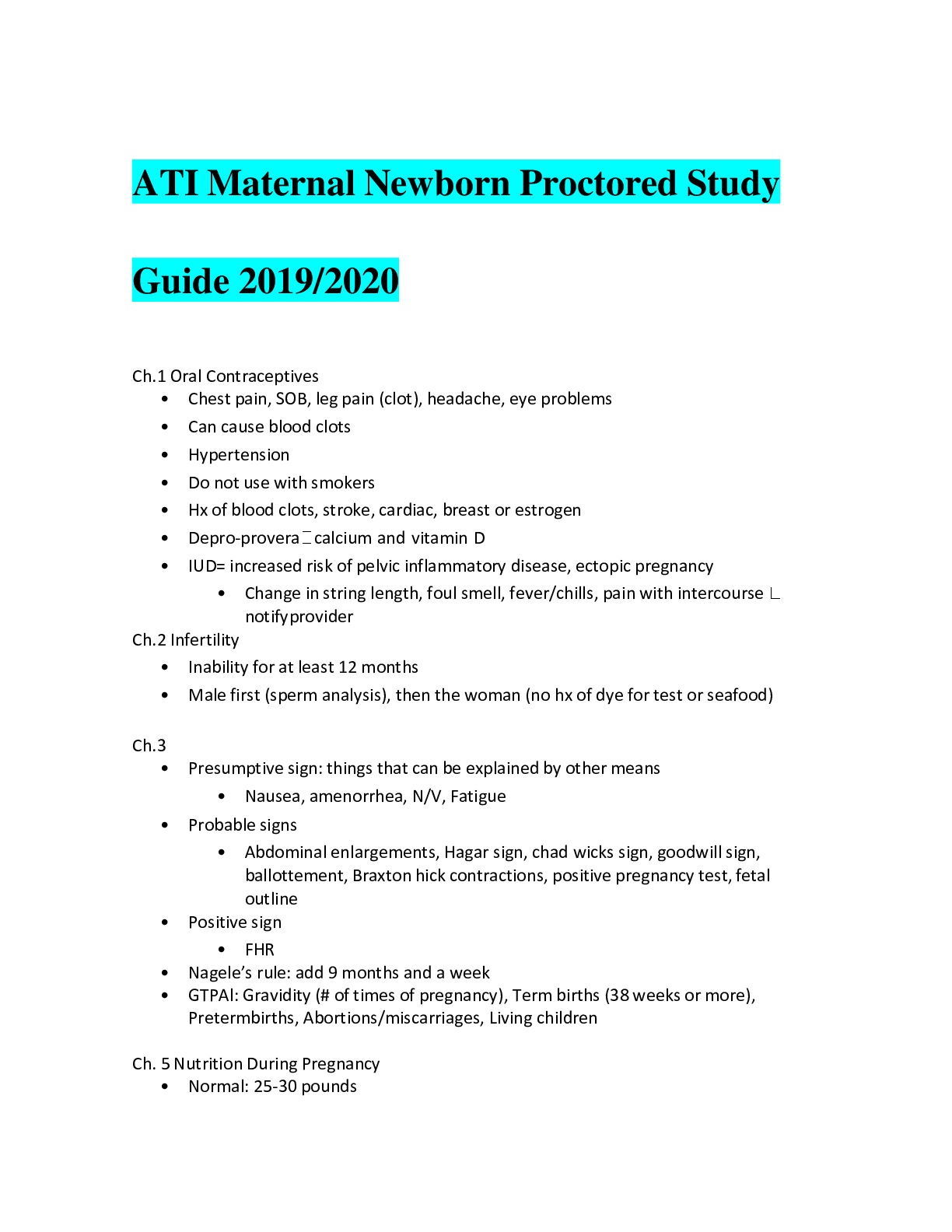

.png)
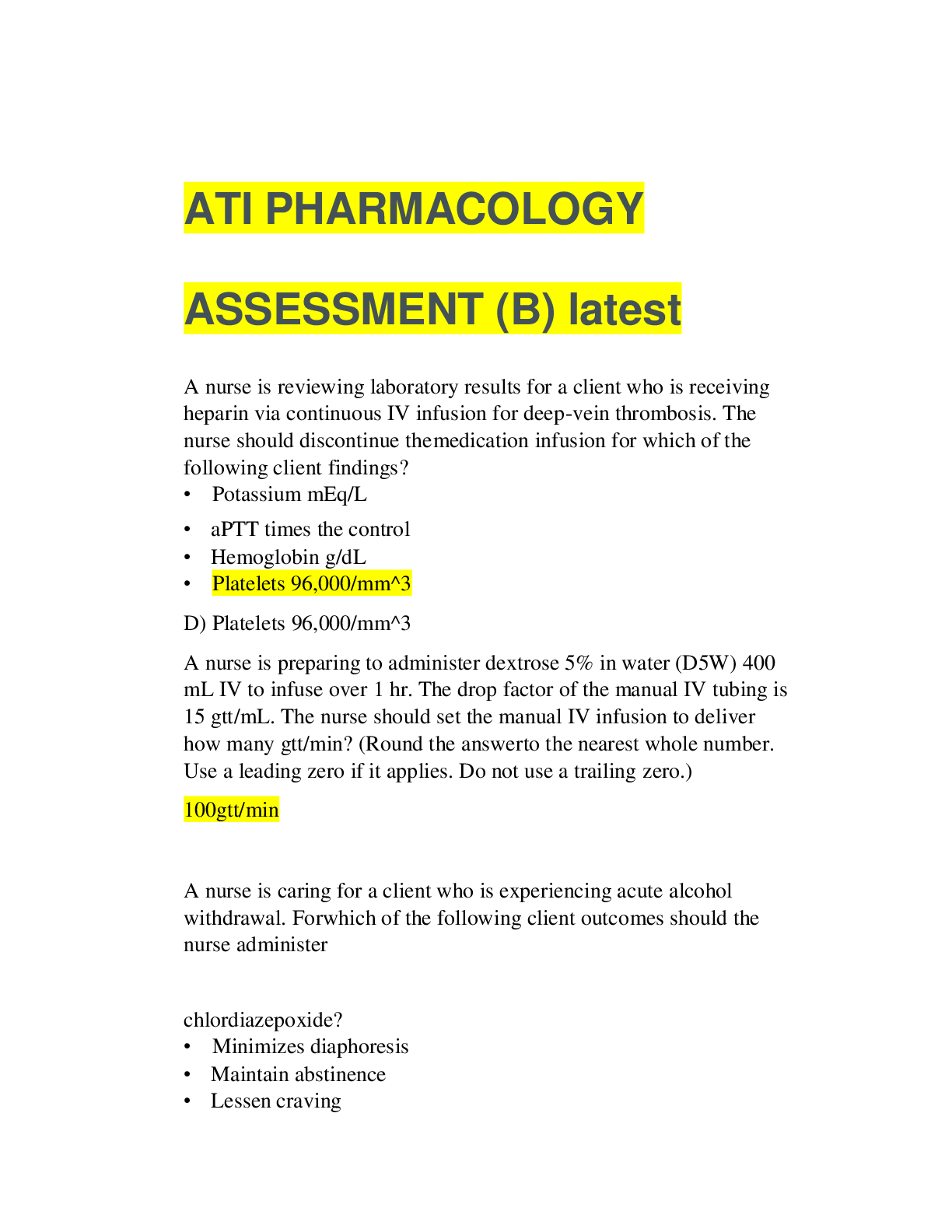
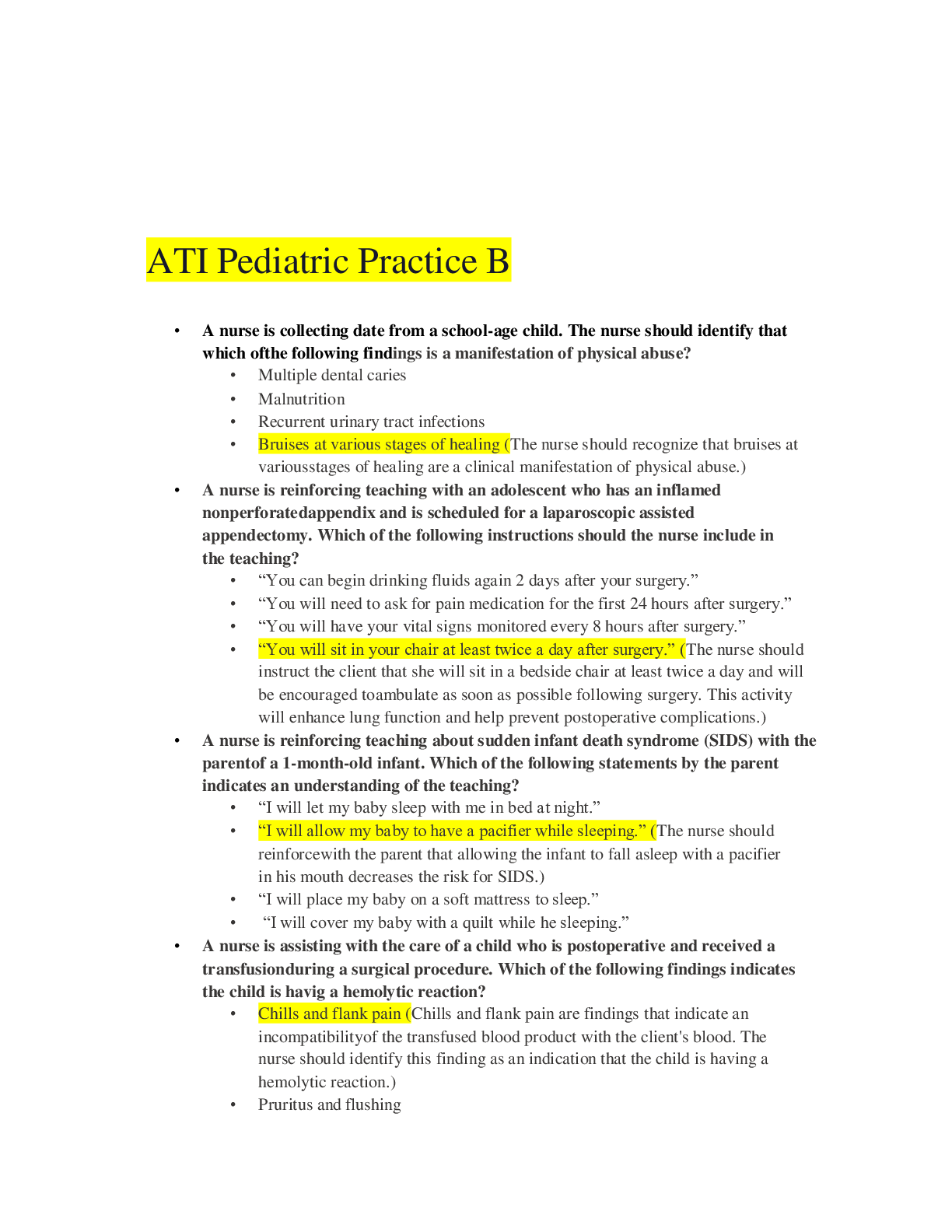
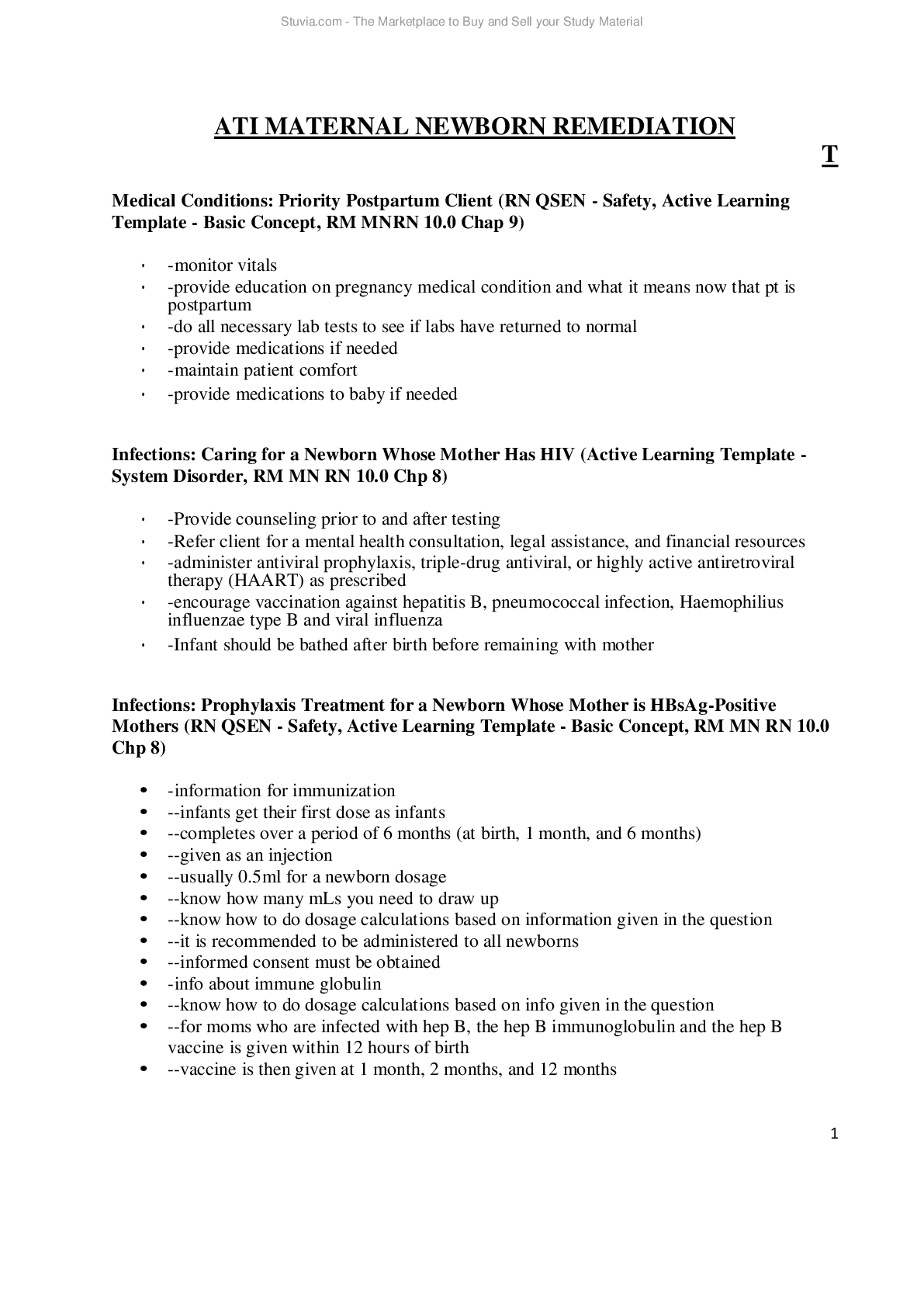

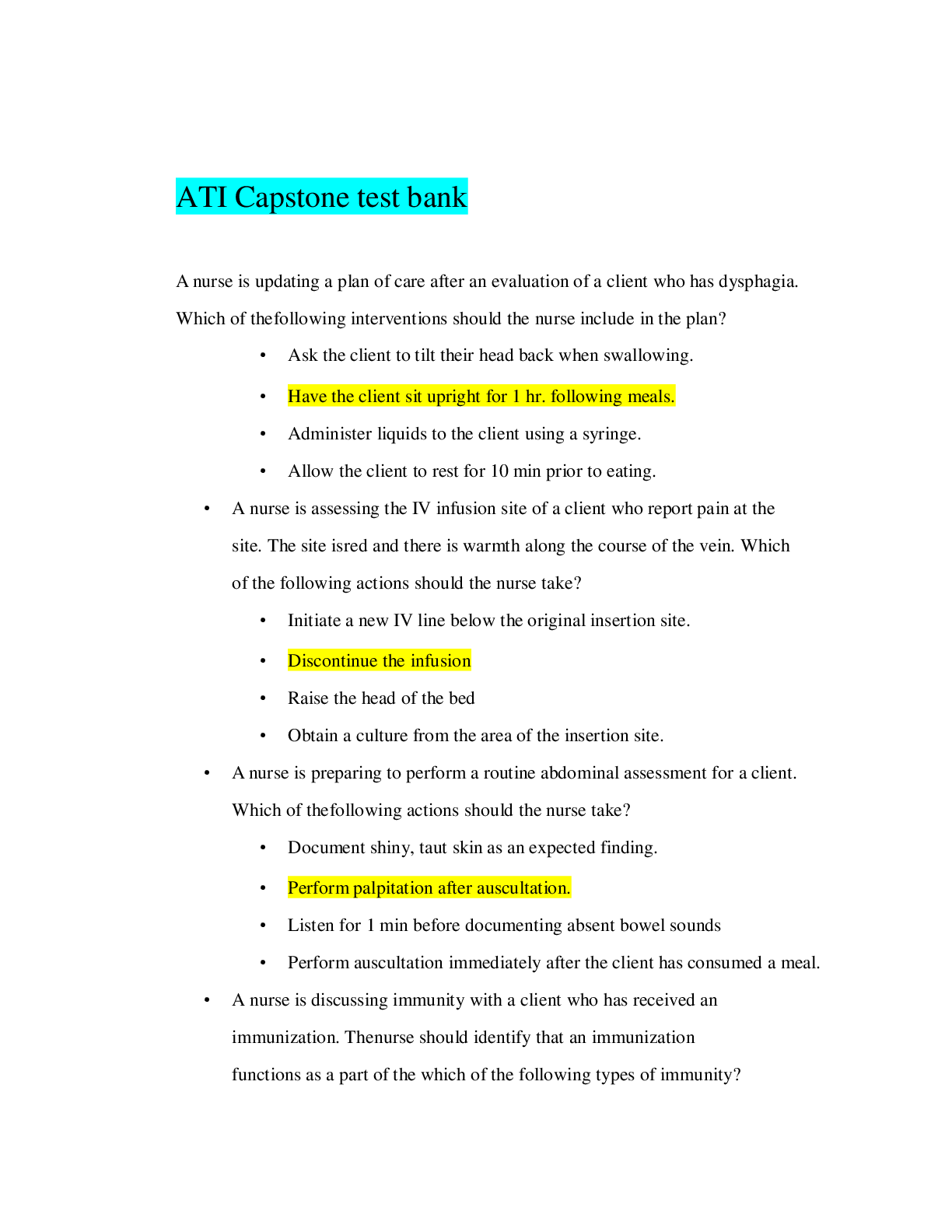

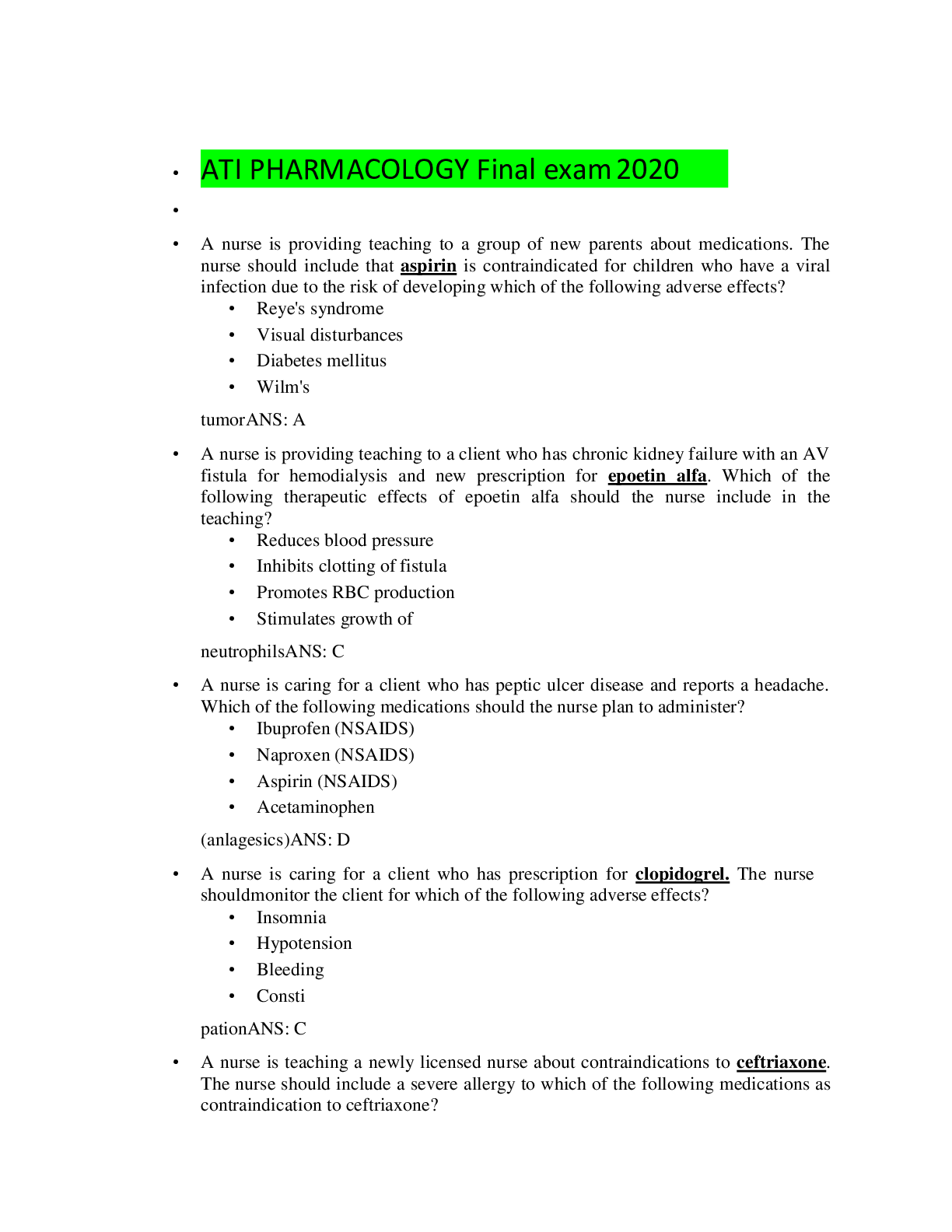
.png)
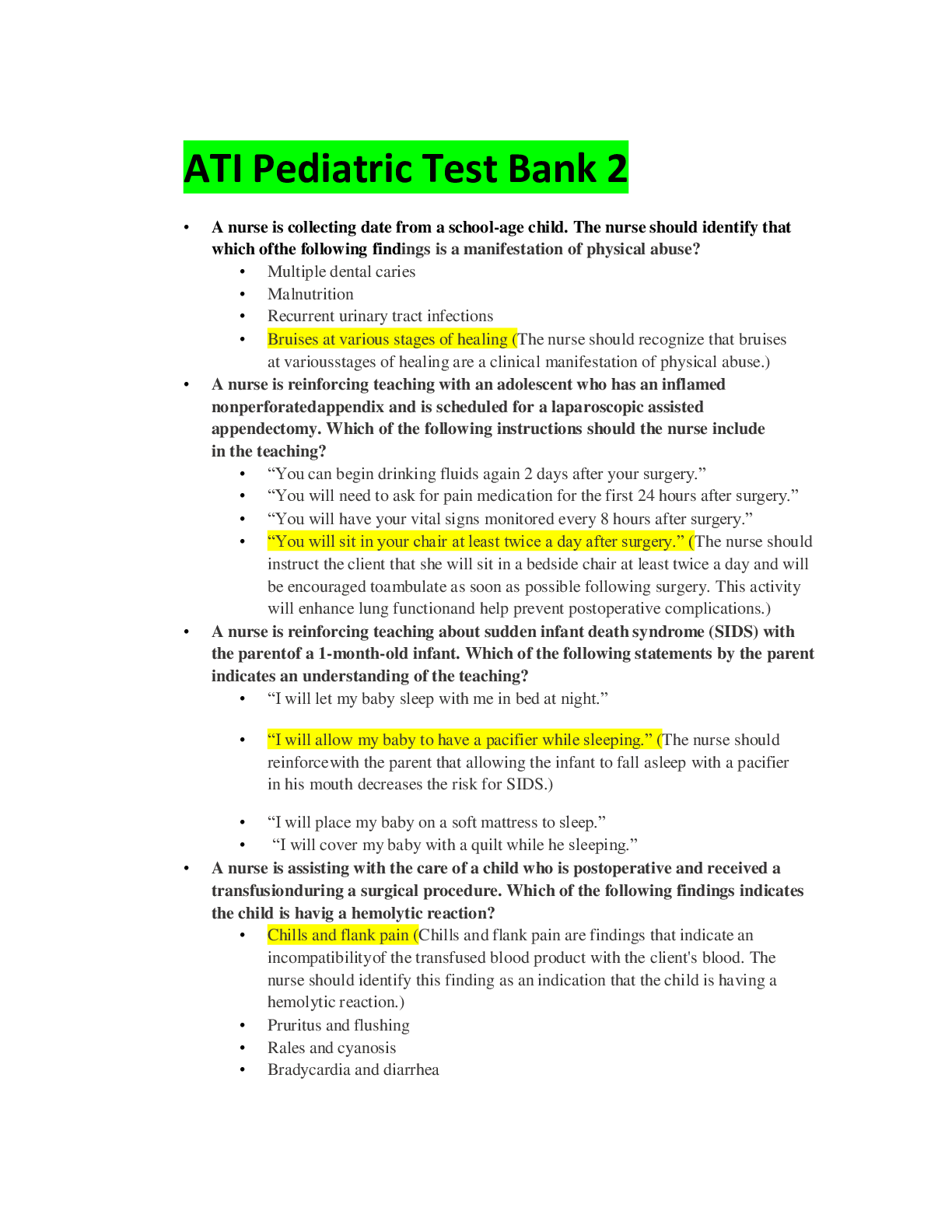


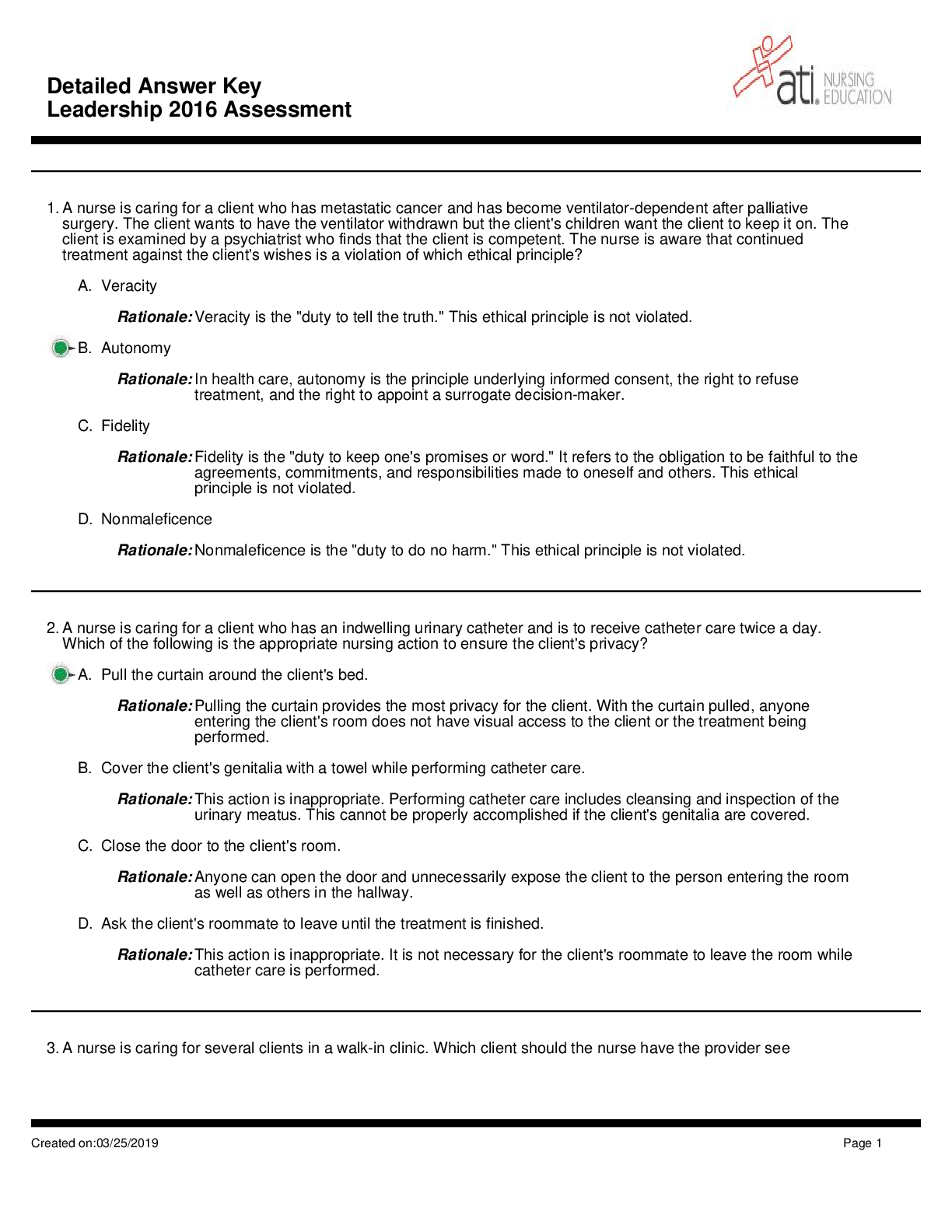
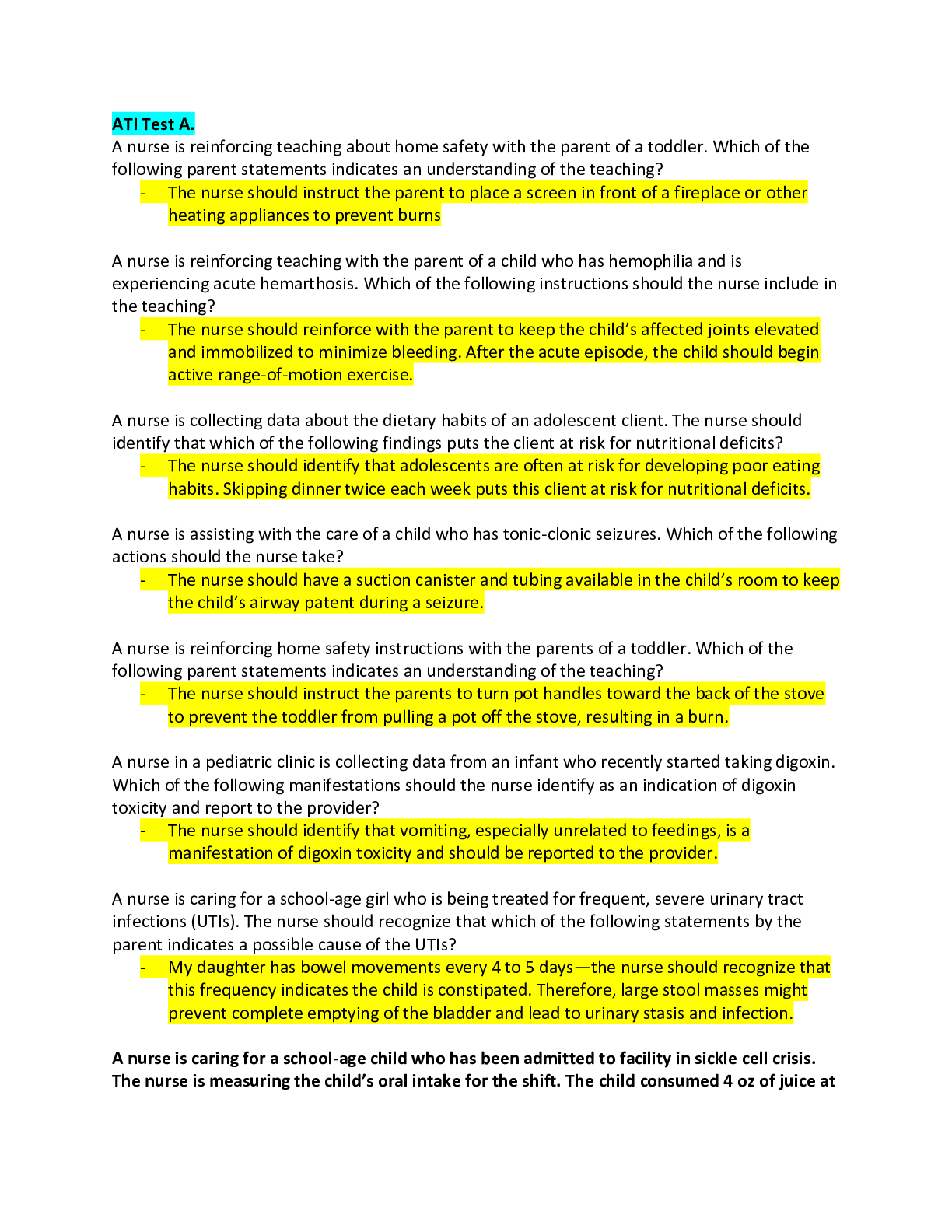
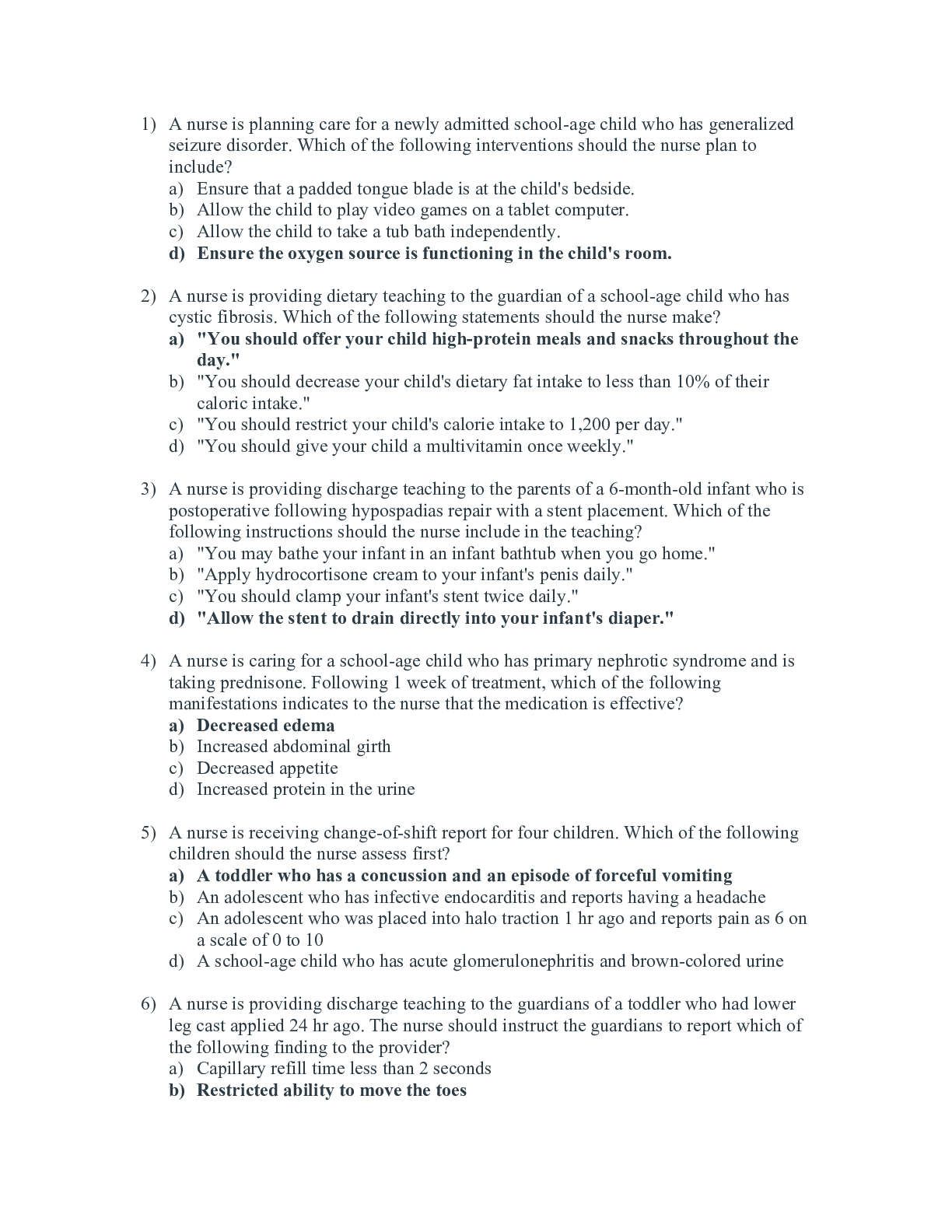
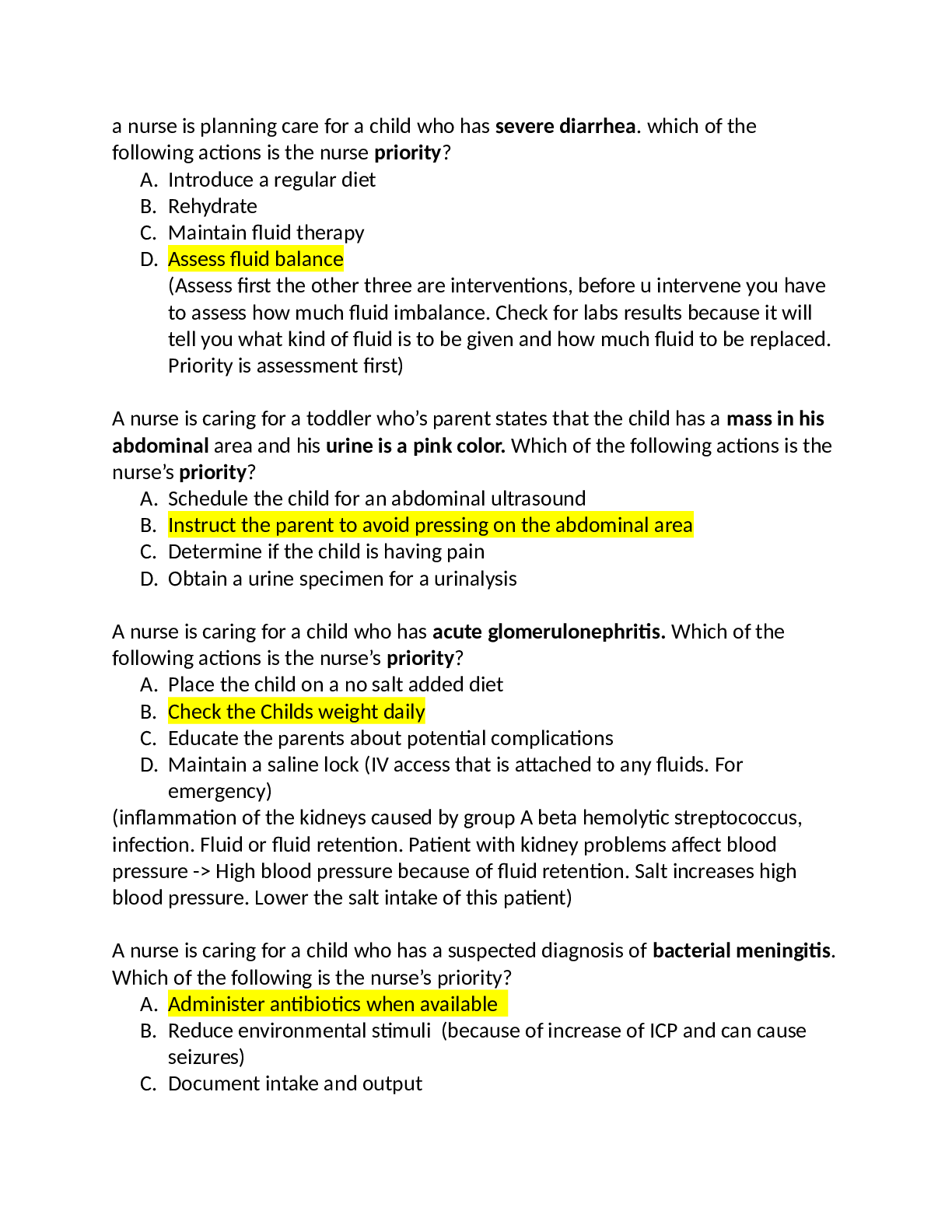
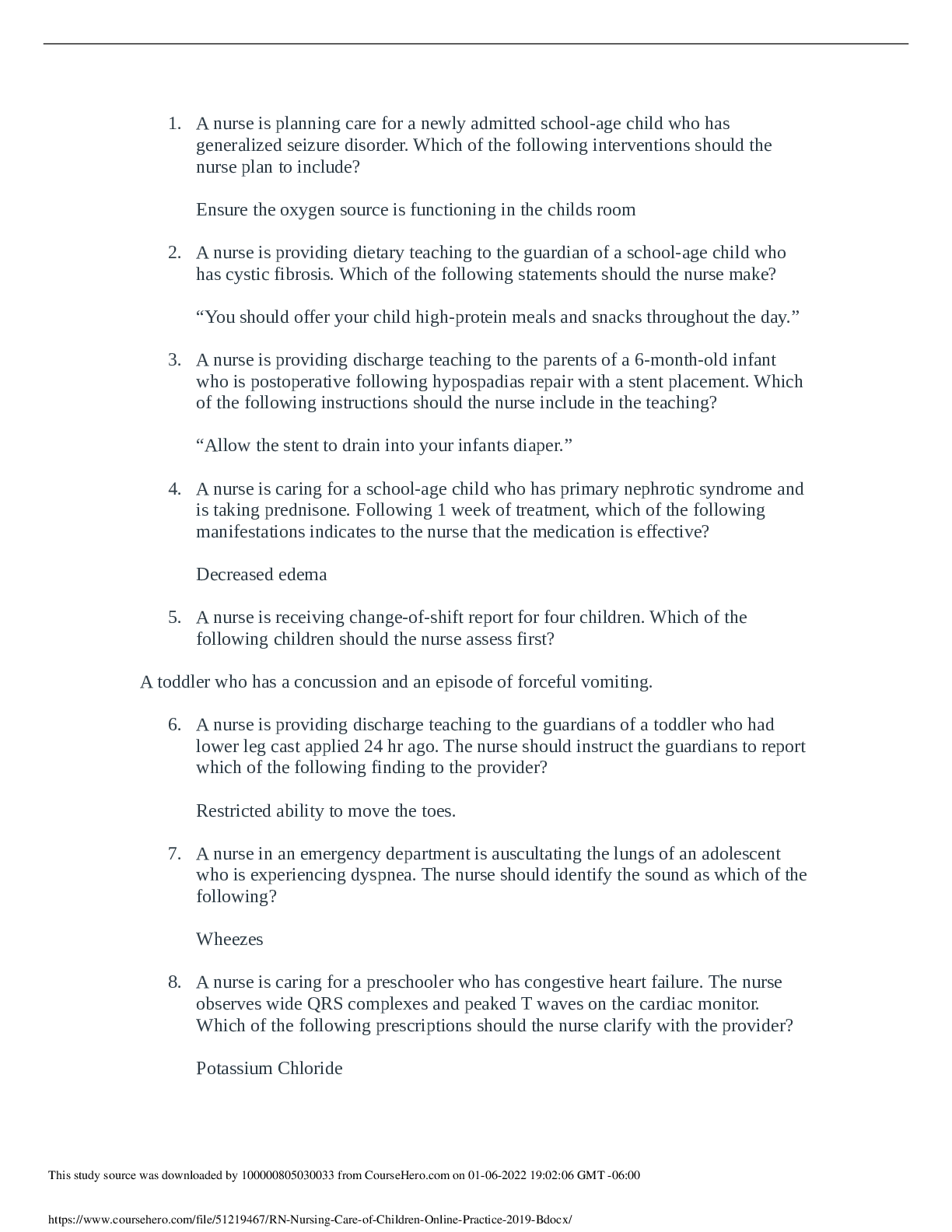
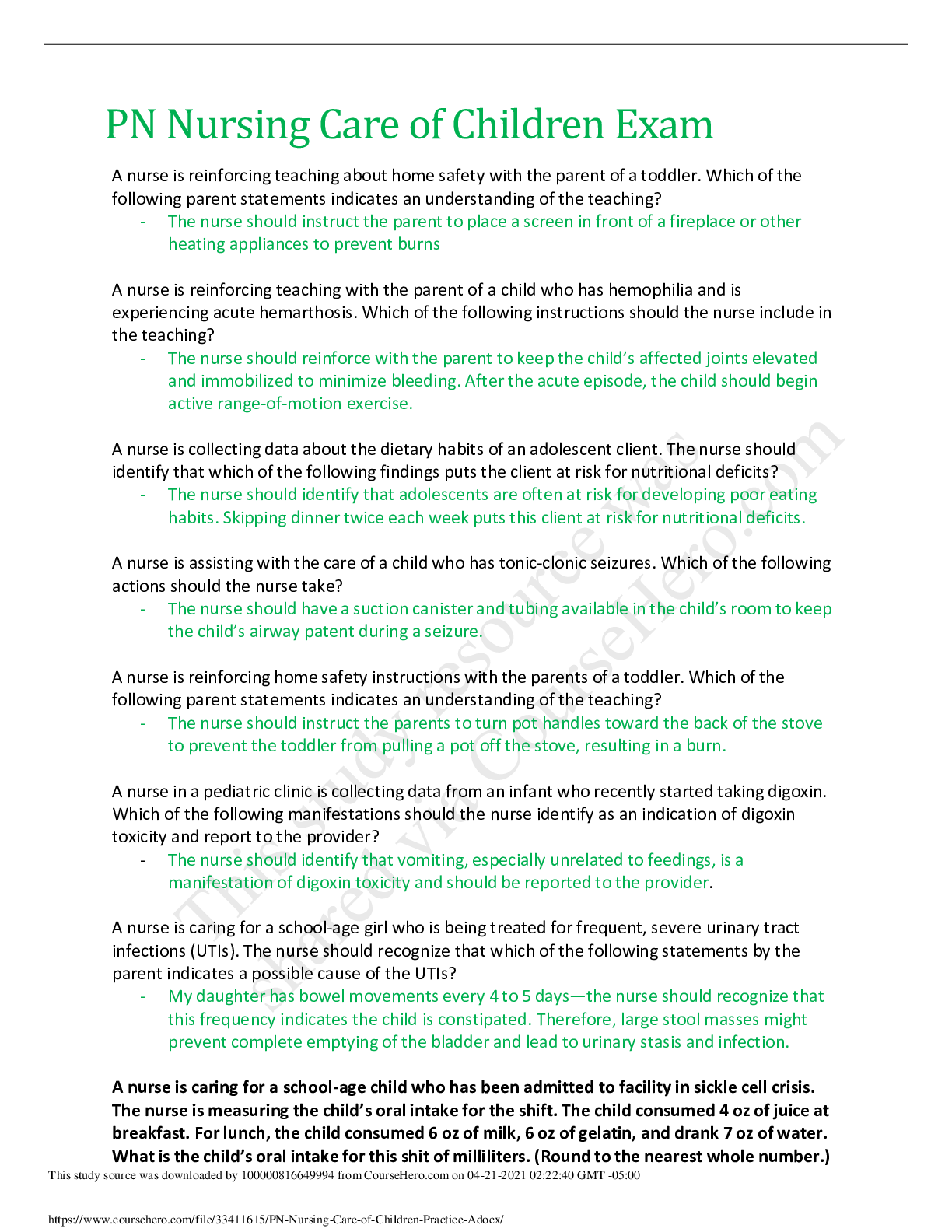
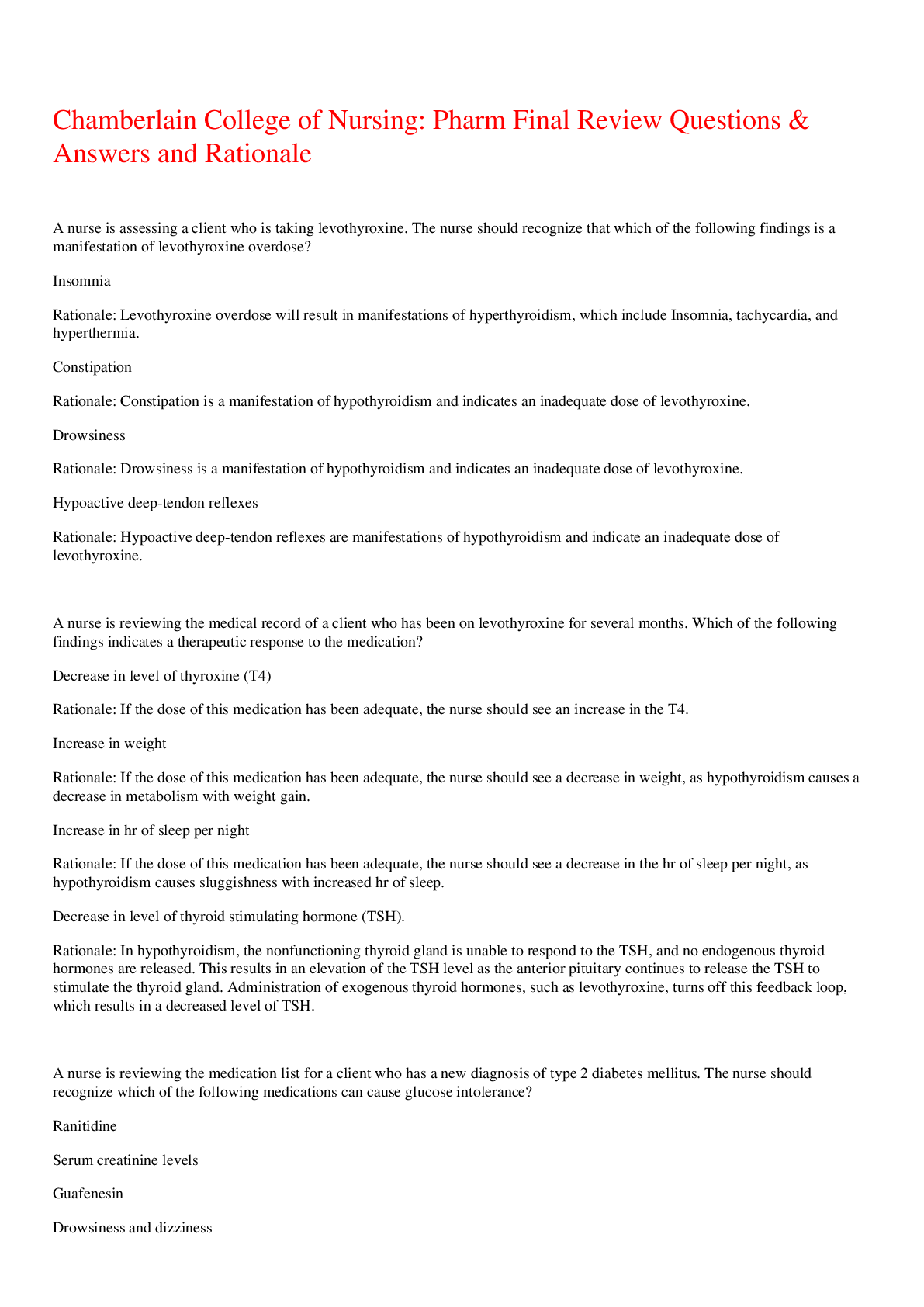
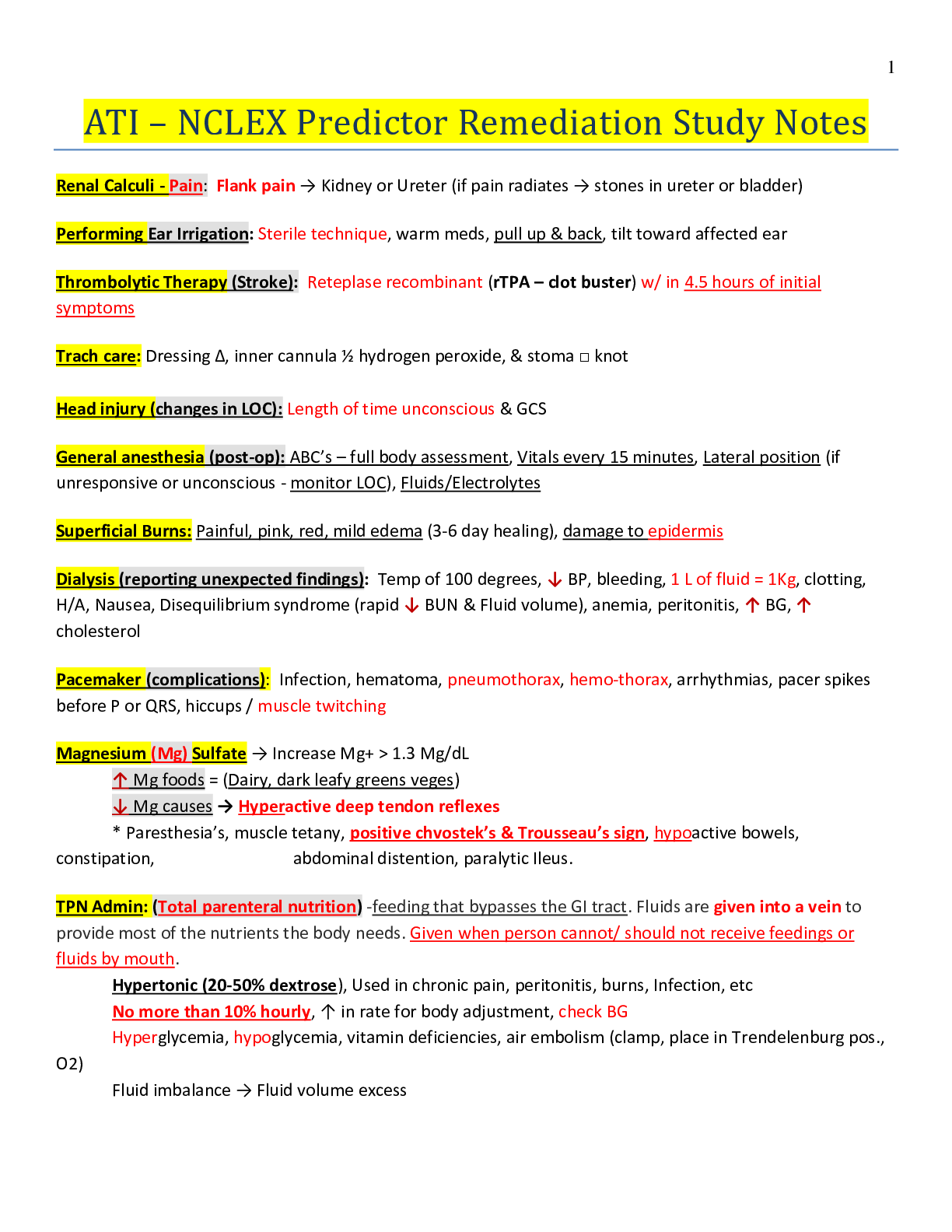
 – Chamberlain College of Nursing.png)
 – Chamberlain College of Nursing.png)

